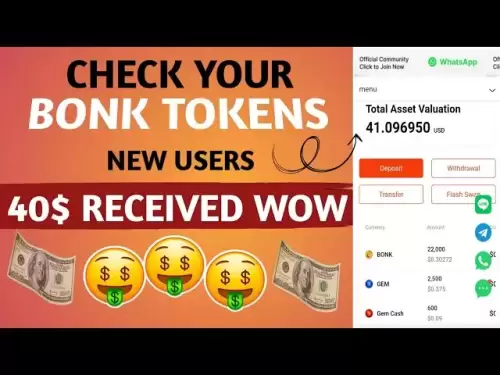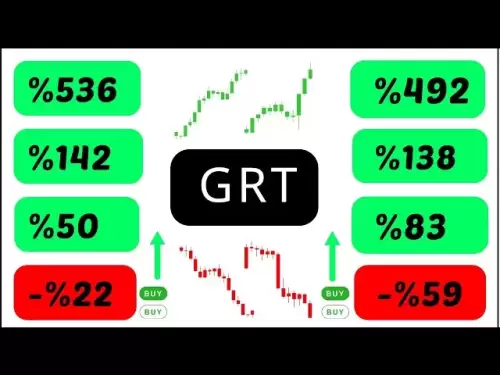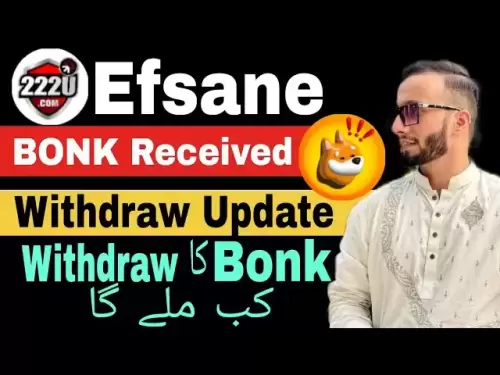-
 Bitcoin
Bitcoin $107,569.2021
1.41% -
 Ethereum
Ethereum $2,430.6950
-0.48% -
 Tether USDt
Tether USDt $1.0005
-0.01% -
 XRP
XRP $2.1884
-0.91% -
 BNB
BNB $647.4445
0.53% -
 Solana
Solana $144.2325
-0.49% -
 USDC
USDC $1.0000
-0.02% -
 TRON
TRON $0.2731
-0.48% -
 Dogecoin
Dogecoin $0.1658
0.61% -
 Cardano
Cardano $0.5694
-2.94% -
 Hyperliquid
Hyperliquid $37.2814
-0.09% -
 Bitcoin Cash
Bitcoin Cash $487.9461
7.41% -
 Sui
Sui $2.7788
-0.50% -
 Chainlink
Chainlink $13.2000
-1.28% -
 UNUS SED LEO
UNUS SED LEO $8.9994
0.22% -
 Stellar
Stellar $0.2417
-2.68% -
 Avalanche
Avalanche $17.6551
-2.73% -
 Toncoin
Toncoin $2.8498
-1.64% -
 Shiba Inu
Shiba Inu $0.0...01166
0.35% -
 Litecoin
Litecoin $84.6510
-0.54% -
 Hedera
Hedera $0.1507
-2.44% -
 Monero
Monero $315.5116
-0.39% -
 Ethena USDe
Ethena USDe $1.0001
-0.04% -
 Polkadot
Polkadot $3.3900
-1.91% -
 Dai
Dai $0.9999
0.00% -
 Bitget Token
Bitget Token $4.4262
3.03% -
 Pi
Pi $0.6122
12.98% -
 Uniswap
Uniswap $7.0039
-0.60% -
 Pepe
Pepe $0.0...09582
-3.75% -
 Aave
Aave $257.8121
-2.70%
What is the CRV transaction fee? Are there differences in fees between different platforms?
Curve.fi's CRV transaction fee is 0.04%, split between LPs and the DAO, while Uniswap and SushiSwap charge 0.3%, and Balancer's fee varies from 0.1% to 0.3%.
May 06, 2025 at 01:21 pm

The CRV transaction fee is a critical aspect that users need to understand when engaging with the Curve.fi platform and other decentralized exchanges (DEXs) that support CRV tokens. Curve.fi, known for its low slippage and efficient stablecoin swaps, uses a unique fee structure that differs from other platforms. In this article, we will delve into the specifics of the CRV transaction fee, examine how fees vary across different platforms, and provide detailed insights into managing these fees effectively.
Understanding CRV Transaction Fees on Curve.fi
Curve.fi operates on a decentralized exchange model, where users can swap between various stablecoins with minimal slippage. The platform's fee structure is designed to be both transparent and efficient. On Curve.fi, the standard transaction fee for swaps is 0.04%. This fee is split between liquidity providers (LPs) and the Curve DAO, with 0.02% going to LPs and 0.02% going to the Curve DAO.
Additionally, Curve.fi implements a dynamic fee model that can adjust based on the pool's liquidity and the size of the transaction. For larger transactions, the fee might slightly increase to prevent front-running and ensure the stability of the pool. Users can check the exact fee for their transaction by using the Curve.fi interface, which displays the fee before confirming the swap.
CRV Transaction Fees on Other Platforms
While Curve.fi has its unique fee structure, other platforms that support CRV tokens may have different fee models. Here, we will explore some of the major platforms and their fee structures for CRV transactions.
Uniswap
Uniswap, a popular DEX, uses a different fee model compared to Curve.fi. For CRV transactions on Uniswap, the standard fee is 0.3%. This fee is entirely distributed to liquidity providers. Unlike Curve.fi, Uniswap does not have a dynamic fee model, so the fee remains constant regardless of transaction size or pool liquidity.
SushiSwap
SushiSwap, another well-known DEX, operates similarly to Uniswap but with a slightly different fee structure. For CRV transactions, SushiSwap charges a standard fee of 0.3%, which is also distributed to liquidity providers. However, SushiSwap has introduced additional features like the Sushi Bar, where users can stake their SUSHI tokens to earn a portion of the platform's fees.
Balancer
Balancer is a more flexible DEX that allows for the creation of custom liquidity pools. For CRV transactions on Balancer, the fee can vary depending on the specific pool's settings. Typically, the fee ranges from 0.1% to 0.3%, with the exact fee determined by the pool's creator. This flexibility allows for more tailored fee structures but can also lead to higher fees in some cases.
Comparing CRV Transaction Fees Across Platforms
To better understand the differences in CRV transaction fees across various platforms, let's compare the standard fees and any additional considerations:
- Curve.fi: Standard fee of 0.04%, split between LPs and the Curve DAO. Dynamic fee adjustments for larger transactions.
- Uniswap: Standard fee of 0.3%, distributed to LPs. No dynamic fee adjustments.
- SushiSwap: Standard fee of 0.3%, distributed to LPs. Additional staking options for earning platform fees.
- Balancer: Variable fee ranging from 0.1% to 0.3%, determined by pool creators. No standard fee across all pools.
Strategies for Minimizing CRV Transaction Fees
Given the differences in fee structures, users can employ several strategies to minimize their CRV transaction fees:
- Choose the Right Platform: For users primarily interested in stablecoin swaps, Curve.fi offers the lowest standard fee. For other types of CRV transactions, Balancer might offer lower fees depending on the specific pool.
- Optimize Transaction Size: On Curve.fi, larger transactions may incur slightly higher fees due to the dynamic fee model. Users should consider breaking large transactions into smaller ones if possible.
- Participate in Staking and Governance: Platforms like SushiSwap and Curve.fi offer staking and governance opportunities that can offset transaction fees. By staking tokens, users can earn a portion of the platform's fees, effectively reducing their net cost.
Detailed Tutorial: Executing a CRV Transaction on Curve.fi
To help users understand how to execute a CRV transaction on Curve.fi with a focus on managing fees, here is a step-by-step guide:
- Access the Curve.fi Interface: Navigate to the Curve.fi website and connect your wallet (e.g., MetaMask).
- Select the Pool: Choose the pool that contains the CRV token you wish to trade. Curve.fi offers various pools, including those for stablecoins and other assets.
- Input the Transaction Amount: Enter the amount of CRV you want to swap. The interface will display the estimated output and the transaction fee.
- Review the Fee: Before confirming the transaction, review the fee displayed on the interface. Ensure you understand the split between LPs and the Curve DAO.
- Confirm the Transaction: Once satisfied with the fee and output, confirm the transaction through your wallet. The transaction will be processed, and you will receive the swapped tokens in your wallet.
Detailed Tutorial: Executing a CRV Transaction on Uniswap
For users interested in executing CRV transactions on Uniswap, follow these steps:
- Access the Uniswap Interface: Navigate to the Uniswap website and connect your wallet.
- Select the Tokens: Choose CRV as the token you want to swap from and select the token you want to receive.
- Input the Transaction Amount: Enter the amount of CRV you want to swap. The interface will display the estimated output and the transaction fee of 0.3%.
- Review the Fee: Before confirming the transaction, review the fee displayed on the interface. The entire fee goes to liquidity providers.
- Confirm the Transaction: Once satisfied with the fee and output, confirm the transaction through your wallet. The transaction will be processed, and you will receive the swapped tokens in your wallet.
Frequently Asked Questions
Q: Can the CRV transaction fee be reduced by using a VPN or changing my location?
A: The CRV transaction fee is determined by the platform's fee structure and is not influenced by your location or the use of a VPN. Fees are set by the smart contracts on the blockchain and are the same for all users regardless of their geographic location.
Q: Are there any platforms that offer zero-fee CRV transactions?
A: Currently, there are no major platforms that offer zero-fee CRV transactions. All platforms charge some form of fee to incentivize liquidity providers and maintain the platform's operations. However, some platforms offer fee discounts or rebates through staking and governance participation.
Q: How do gas fees affect CRV transaction fees?
A: Gas fees, which are fees paid to the Ethereum network for processing transactions, are separate from the platform's transaction fees. While gas fees can vary and may impact the overall cost of a CRV transaction, they do not directly affect the platform's fee structure. Users should consider both gas fees and platform fees when calculating the total cost of a transaction.
Q: Can I negotiate or reduce the CRV transaction fee on decentralized exchanges?
A: Decentralized exchanges operate on smart contracts, and the fees are set by these contracts. Therefore, it is not possible to negotiate or reduce the transaction fee directly. However, users can minimize their fees by choosing the right platform, optimizing transaction sizes, and participating in staking and governance opportunities.
Disclaimer:info@kdj.com
The information provided is not trading advice. kdj.com does not assume any responsibility for any investments made based on the information provided in this article. Cryptocurrencies are highly volatile and it is highly recommended that you invest with caution after thorough research!
If you believe that the content used on this website infringes your copyright, please contact us immediately (info@kdj.com) and we will delete it promptly.
- Bitcoin, Dogecoin, Ethereum: Decoding the Crypto Buzz
- 2025-06-26 04:25:12
- Jupiter (JUP) Price: Downtrend in Danger? Trend Shift Watch!
- 2025-06-26 04:25:12
- Dogecoin Price Prediction: Crypto Analyst Eyes $1 Target – Is the Meme Coin Ready to Rally?
- 2025-06-26 04:45:12
- Coinbase, Shares, and Stablecoins: Riding the Crypto Wave
- 2025-06-26 04:30:12
- Tether, Bitcoin, and Crypto Funds: A New York Minute on the Latest Moves
- 2025-06-26 05:25:12
- Bitcoin Price: Is a Drop Incoming? Analyzing the Latest Predictions
- 2025-06-26 05:25:12
Related knowledge

How to customize USDT TRC20 mining fees? Flexible adjustment tutorial
Jun 13,2025 at 01:42am
Understanding USDT TRC20 Mining FeesMining fees on the TRON (TRC20) network are essential for processing transactions. Unlike Bitcoin or Ethereum, where miners directly validate transactions, TRON uses a delegated proof-of-stake (DPoS) mechanism. However, users still need to pay bandwidth and energy fees, which are collectively referred to as 'mining fe...

USDT TRC20 transaction is stuck? Solution summary
Jun 14,2025 at 11:15pm
Understanding USDT TRC20 TransactionsWhen users mention that a USDT TRC20 transaction is stuck, they typically refer to a situation where the transfer of Tether (USDT) on the TRON blockchain has not been confirmed for an extended period. This issue may arise due to various reasons such as network congestion, insufficient transaction fees, or wallet-rela...

How to cancel USDT TRC20 unconfirmed transactions? Operation guide
Jun 13,2025 at 11:01pm
Understanding USDT TRC20 Unconfirmed TransactionsWhen dealing with USDT TRC20 transactions, it’s crucial to understand what an unconfirmed transaction means. An unconfirmed transaction is one that has been broadcasted to the blockchain network but hasn’t yet been included in a block. This typically occurs due to low transaction fees or network congestio...

How to check USDT TRC20 balance? Introduction to multiple query methods
Jun 21,2025 at 02:42am
Understanding USDT TRC20 and Its ImportanceUSDT (Tether) is one of the most widely used stablecoins in the cryptocurrency market. It exists on multiple blockchain networks, including TRC20, which operates on the Tron (TRX) network. Checking your USDT TRC20 balance accurately is crucial for users who hold or transact with this asset. Whether you're sendi...

What to do if USDT TRC20 transfers are congested? Speed up trading skills
Jun 13,2025 at 09:56am
Understanding USDT TRC20 Transfer CongestionWhen transferring USDT TRC20, users may occasionally experience delays or congestion. This typically occurs due to network overload on the TRON blockchain, which hosts the TRC20 version of Tether. Unlike the ERC20 variant (which runs on Ethereum), TRC20 transactions are generally faster and cheaper, but during...

The relationship between USDT TRC20 and TRON chain: technical background analysis
Jun 12,2025 at 01:28pm
What is USDT TRC20?USDT TRC20 refers to the Tether (USDT) token issued on the TRON blockchain using the TRC-20 standard. Unlike the more commonly known ERC-20 version of USDT (which runs on Ethereum), the TRC-20 variant leverages the TRON network's infrastructure for faster and cheaper transactions. The emergence of this version came as part of Tether’s...

How to customize USDT TRC20 mining fees? Flexible adjustment tutorial
Jun 13,2025 at 01:42am
Understanding USDT TRC20 Mining FeesMining fees on the TRON (TRC20) network are essential for processing transactions. Unlike Bitcoin or Ethereum, where miners directly validate transactions, TRON uses a delegated proof-of-stake (DPoS) mechanism. However, users still need to pay bandwidth and energy fees, which are collectively referred to as 'mining fe...

USDT TRC20 transaction is stuck? Solution summary
Jun 14,2025 at 11:15pm
Understanding USDT TRC20 TransactionsWhen users mention that a USDT TRC20 transaction is stuck, they typically refer to a situation where the transfer of Tether (USDT) on the TRON blockchain has not been confirmed for an extended period. This issue may arise due to various reasons such as network congestion, insufficient transaction fees, or wallet-rela...

How to cancel USDT TRC20 unconfirmed transactions? Operation guide
Jun 13,2025 at 11:01pm
Understanding USDT TRC20 Unconfirmed TransactionsWhen dealing with USDT TRC20 transactions, it’s crucial to understand what an unconfirmed transaction means. An unconfirmed transaction is one that has been broadcasted to the blockchain network but hasn’t yet been included in a block. This typically occurs due to low transaction fees or network congestio...

How to check USDT TRC20 balance? Introduction to multiple query methods
Jun 21,2025 at 02:42am
Understanding USDT TRC20 and Its ImportanceUSDT (Tether) is one of the most widely used stablecoins in the cryptocurrency market. It exists on multiple blockchain networks, including TRC20, which operates on the Tron (TRX) network. Checking your USDT TRC20 balance accurately is crucial for users who hold or transact with this asset. Whether you're sendi...

What to do if USDT TRC20 transfers are congested? Speed up trading skills
Jun 13,2025 at 09:56am
Understanding USDT TRC20 Transfer CongestionWhen transferring USDT TRC20, users may occasionally experience delays or congestion. This typically occurs due to network overload on the TRON blockchain, which hosts the TRC20 version of Tether. Unlike the ERC20 variant (which runs on Ethereum), TRC20 transactions are generally faster and cheaper, but during...

The relationship between USDT TRC20 and TRON chain: technical background analysis
Jun 12,2025 at 01:28pm
What is USDT TRC20?USDT TRC20 refers to the Tether (USDT) token issued on the TRON blockchain using the TRC-20 standard. Unlike the more commonly known ERC-20 version of USDT (which runs on Ethereum), the TRC-20 variant leverages the TRON network's infrastructure for faster and cheaper transactions. The emergence of this version came as part of Tether’s...
See all articles
























































































